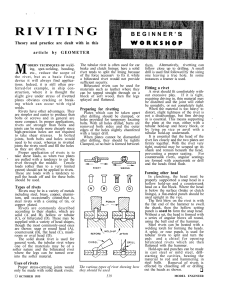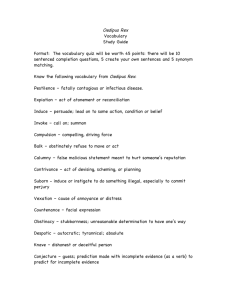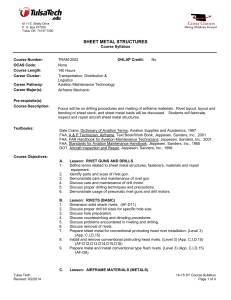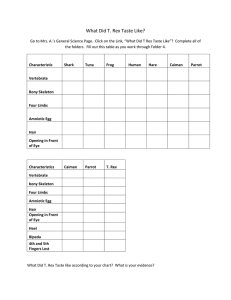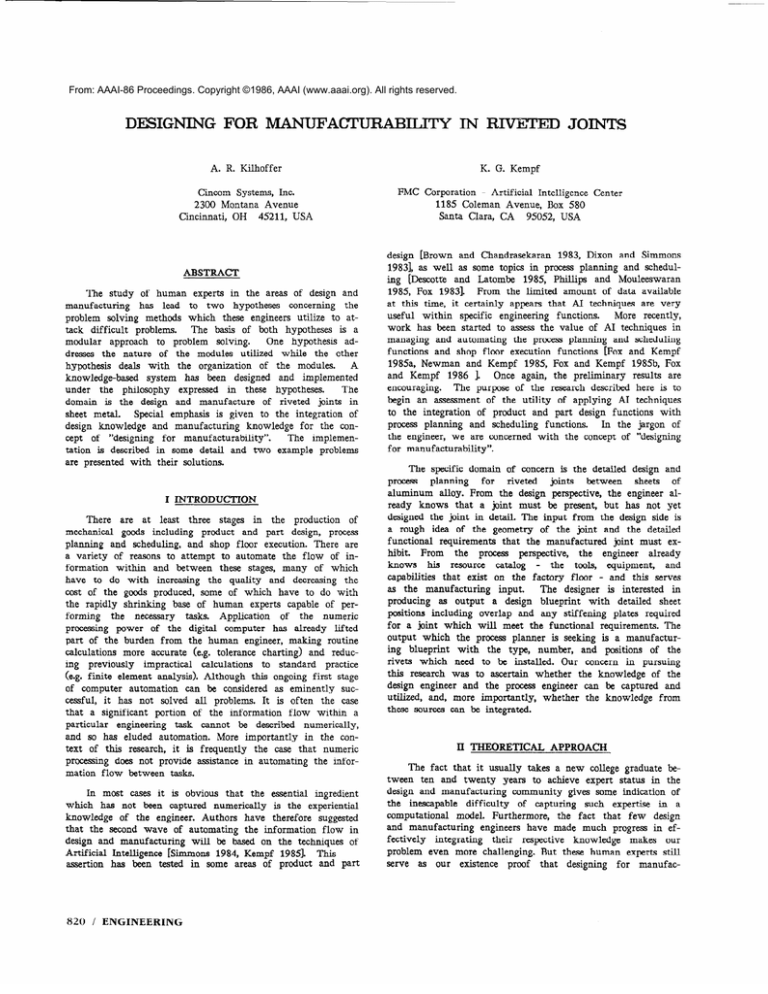
From: AAAI-86 Proceedings. Copyright ©1986, AAAI (www.aaai.org). All rights reserved.
DESIGNING FOR MANUFACTURABILITY
K. G. Kempf
Cincom Systems, Inc.
2300 Montana Avenue
Cincinnati, OH 45211, USA
FMC Corporation - Artificial Intelligence Center
1185 Coleman Avenue, Box 580
Santa Clara, CA 95052, USA
The study of human experts in the areas of design and
manufacturing
has lead to two hypotheses concerning the
problem solving methods which these engineers utilize to atThe basis of both hypotheses is a
tack difficult problems.
One hypothesis admodular approach to problem solving.
dresses the nature of the modules utilized while the other
hypothesis deals with the organization of the modules.
A
knowledge-based system has been designed and implemented
under the philosophy expressed in these hypotheses.
The
domain is the design and manufacture
of riveted joints in
Special emphasis is given to the integration of
sheet metal.
design knowledge and manufacturing
knowledge for the concept of “designing for manufacturability”.
The implementation is described in some detail and two example problems
are presented with their solutions.
I INTRODUCTION
There are at least three stages in the production of
mechanical goods including product and part design, process
planning and scheduling, and shop floor execution. There are
a variety of reasons to attempt to automate the flow of information within and between these stages, many of which
have to do with increasing the quality and decreasing the
cost of the goods produced, some of which have to do with
the rapidly shrinking base of human experts capable of performing the necessary tasks. Application
of the numeric
processing power of the digital computer has already lifted
part of the burden from the human engineer, making routine
calculations more accurate (e.g. tolerance charting) and reducing previously
impractical calculations to standard practice
(e.g. finite element analysis). Although this ongoing first stage
of computer automation can be considered as eminently successful, it has not solved all problems. It is often the case
that a significant portion of the information flow within a
particular engineering task cannot be described numerically,
and so has eluded automation. More importantly in the context of this research, it is frequently the case that numeric
processing does not provide assistance in automating the information flow between tasks.
In most cases it is obvious that the essential ingredient
which has not been captured numerically is the experiential
knowledge of the engineer. Authors have therefore suggested
that the second wave of automating the information flow in
design and manufacturing
will be based on the techniques of
Artificial Intelligence [Simmons 1984, Kempf 19851. This
assertion has been tested in some areas of product and part
/ ENGINEERING
JOINTS
A. R. Kilhoffer
ABSTRACT
820
IN RIVETED
design [Brown and Chandrasekaran 1983, Dixon and Simmons
19 831, as well as some topics in process planning and scheduling [Descotte and Latombe 1985, Phillips and Mouleeswaran
1985, Fox 19831. From the limited amount of data available
at this time, it certainly appears that AI techniques are very
useful within specific engineering functions.
More recently,
work has been started to assess the value of AI techniques in
managing and automating the process planning and scheduling
functions and shop floor execution functions [Fox and Kempf
1985a, Newman and Kempf 1985, Fox and Kempf 1985b, Fox
and Kempf 1986 1. Once again, the preliminary results are
encouraging.
The purpose of the research described here is to
begin an assessment of the utility of applying AI techniques
to the integration of product and part design functions with
process planning and scheduling functions.
In the jargon of
the engineer, we are concerned with the concept of “designing
for manufacturability”.
The specific domain of concern is the detailed design and
process planning
for
riveted
joints
between
sheets of
aluminum alloy. From the design perspective, the engineer already knows that a joint must be present, but has not yet
designed the joint in detail. The input from the design side is
a rough idea of the geometry of the joint and the detailed
functional requirements that the manufactured joint must exhibit. From the process perspective, the engineer already
knows his resource catalog - the tools, equipment,
and
capabilities that exist on the factory floor - and this serves
as the manufacturing
input.
The designer is interested in
producing as output a design blueprint with detailed sheet
positions including overlap and any stiffening plates required
for a joint which will meet the functional requirements. The
output which the process planner is seeking is a manufacturing blueprint with the type, number, and positions of the
rivets which need to be installed. Our concern in pursuing
this research was to ascertain whether the knowledge of the
design engineer and the process engineer can be captured and
utilized, and, more importantly, whether the knowledge from
these sources can be integrated.
II THEORETICAL
APPROACH
The fact that it usually takes a new college graduate between ten and twenty years to achieve expert status in the
design and manufacturing community gives some indication of
the inescapable difficulty
of capturing such expertise in a
computational model. Furthermore, the fact that few design
and manufacturing
engineers have made much progress in effectively
integrating
their respective knowledge makes our
problem even more challenging. But these human experts still
serve as our existence proof that designing for manufac-
turability
is possible. It is through careful observation of
these experts that a phenomenonological model of their reasoning methods has begun to emerge. This model is still tentative, containing errors of omission and commission, but
serves as the basis for the implementation described here.
encountered fairly frequently. In this module, knowledge, often held as constraints, is used to prune a search space with
the goal of ascertaining whether any solution remains. The
response set includes no, yes, and maybe, the latter two accompanied by subspaces which require further investigation.
Design and manufacturing
experts give the impression
that they solve problems in a modular fashion. Our current
model of their methods includes two major hypotheses. One
hypothesis concerns the organization of the reasoning modules
used while the other involves the identity of the modules included in the process. It is encouraging to note that both of
these hypotheses map onto existing AI techniques.
In terms of module organization, the experts observed
decompose the problems which they attempt to solve in two
distinct ways (Figure 1). On one hand, they use techniques
such as top down reasoning and hierarchical abstraction, solving the problem at many levels of detail, usually working
from less detail to more detail (the vertical bars in Figure 1).
In this process they usually have a different representation of
the problem and bring different knowledge to bear at each
level. On the other hand, they use techniques such as divide
and conquer and cooperative problem solving. Within
the
same level of abstraction, using a consistent problem representation, the problem is dissected into separate but related pieces
(the horizontal bars in Figure 1). These subproblems are then
attacked using the appropriate knowledge for each.
Data
Result
a) Algorithmic
Data
Satisficing
set
More
abstract
set of
subproblems
4
Selection
Less
abstract
set of
subproblems
Figure 1. Basic Organization of Design
and Manufacturing Expertise
In terms of module identity, the experts observed use a
wide variety of distinct reasoning methods (Figure 2). Some
of these modules are described here with the qualification
that the list is in no way exhaustive, including only those
modules which are needed to describe our implementation.
Notice that while the modules presented are all described at a
common level, each can be applied at any level of abstraction
or dissection presented in Figure 1.
A module which is often encountered is the algorithmic
module shown in Figure 2a. The basic idea here is to
numerically compute a result given some data, but this often
involves application of expert knowledge to select the appropriate equations or tables, to correctly insert or extract the
data, and to interpret
the result in the context of the
problem at hand. A second commonly encountered module is
the knowledge-based
selection module shown in Figure 2b.
Here the idea is to apply knowledge, often held as rules, to
determine the heuristically best selection from a set, all the
members of which might potentially suffice as solutions. The
knowledge-based restriction module shown in Figure 2c is also
1M
Constraints
Rules
Abstraction
module
b) Rule-based
selection module
Go
Maybe
NoGo
(and subspace)
c) Constraint-based
restriction module
Figure 2. Some Modules of Design and
Manufacturing Expertise
In summary, the first hypothesis concerns an abstraction
and dissection hierarchy of problem solving activity while the
second hypothesis deals with a subset of current problem
solving techniques (also expressible as an abstraction hierarchy
from a more global perspective). Our implementation attempts
a mapping between these two structures in the context of
designing for manufacturability
for riveted joints.
III IMPLEMENTATION
APPROACH
The implementation
described here represents an initial
attempt to provide intelligent automated assistance to engineers
concerned with the riveting, welding, bonding (with glue),
and fastening (with bolts) of aluminum, steel, and titanium
sheets in various geometries. It also serves as a test for the
two hypotheses outlined earlier. The subsystem described here
is called REX (Riveting Expert) and addresses the riveting of
aluminum sheets. REX is implemented in VAX Common LISP
(version 1.0) and runs under VMS (version 4.1A) on a VAX
8600. The current system represents roughly 350 hours of
knowledge
collection
including
direct interaction
with
a
domain expert and study of documents provided by the expert. A few dozen example problems were solved during the
APPLICATIONS
/ 821
collection process. The system provides useful assistance to an
engineer with many years of experience in that it frees the
engineer from making detailed considerations, thereby promoting a more global view of the problem at hand, and provides
consistent, quality solutions quickly (roughly one minute of
user input followed by one to two minutes of REX run
time>.
representations
in REX are composed of
Knowledge
frames, each frame with any number of slots, each slot
having value and default facets. In some cases, slots contain
the attributes of objects while the value and default facets
contain individual or inclusive (or exclusive) sets of reals, integers, or strings. Slots can also indicate inheritance with facet
values taking on the frame names of parents and children.
Values about the problem at hand are supplied by the user
while the domain expert supplies values about the domain,
the defaults, and inheritance. In other cases, default facets are
not used, but value facets can contain executable constraints
or rules supplied by the domain expert as well as textual explanation for the user and source information
for system
maintenance. Slots can also provide focus of attention containing frame names of related or associated constraints and rules.
The input to REX consists of two frames.
One is user
supplied and contains a detailed description of the problem to
The contents are divided into two major sections
be solved.
In the materials section, infor- materials and requirements.
mation about composition is made available including metal
type (currently
limited to aluminum),
alloy number, and
ALso stored in the materials section is the
temper condition.
length, width, and thickness of the pieces to be joined. Note
that the two pieces can have different compositions and/or
dimensions.
Finally, the materials section contains information
about the basic joint geometry (currently limited to flat joints
although L-shaped and T-shaped joints have been considered)
and about how many sides of the joint will be accessible
during manufacturing.
In the requirements section, the loads
to which the finished joint will be subjected are described by
a type (currently limited to axial sheer although other types
have been considered) and a magnitude.
Appearance requirements are also stored here and include flushness relative to
sheet edges and relative to rivet heads. Finally, the requirements section contains information about the operational environment that the finished joint must withstand (currently
limited to vibration although corrosion and temperature have
been considered).
The other input frame is user modifiable and contains
design and manufacturing
criteria. The design criteria include
safety margin and weight criticality information.
REX uses
the safety margin data to design the joint to handle worse
case overloads. The weight criticality data is considered whenever there is a design tradeoff to be made and there is an
option to minimize the amount of sheet overlap or minim%
the number or size of rivets. The manufacturing
criteria are
included in two forms. On one hand there is riveting technology data about the limits of riveting in any shop regardExamples might include the standard length
less of facilities.
and dimensions of rivets supplied by manufacturers
or the
minimum rivet “drive-up” possible (the amount of shank flattened during rivet installation). On the other hand there is
data about the particular
facilities with which the user
operates. Examples could include the minimum translational
motion of automatic riveting equipment or the maximum
gauge of sheet which can be bent to form joggled joints.
822
/ ENGINEERING
The output from the system consists of a precise design
and manufacturing
specification of the joint to be riveted.
One part of the specification contains information especially
interesting to the design engineer and consists of the detailed
positions of the sheets including overlap and the description
and location of any additional strengthening sheets that REX
has decided are needed. The other part of the specification is
particularly interesting to the manufacturing engineer since it
contains the type, number, and position of the rivets which
need to be installed.
Data
Fail
0
II
)
Fail
v
Succeed
Figure 3. Organization of
Riveting Expertise
a) Simple lap joint
b) Joggle lap joint
I
I
I
c) Single splice butt joint
I
I
d) Double splice butt joint
Figure 4. Joint Types
REX operates at three levels of abstraction, each with its
own problem representation, each with access to the problem
and criteria frames. At the abstract level of module I (Figure
3), the problem is to decide the suitability of using riveting
technology to produce the joint described under the criteria
given. The problem representation is thus in terms of the
overall
limits
of riveting
for any joint regardless
of
geometry. At the intermediate level of module II (Figure 31,
the problem is to design the geometry of the joint. Thus, the
is in terms of the number
and relative
representation
geometric position of the sheets involved as shown in Figure
4 for flat joints. At the detailed level of modules III and IV
(Figure 31, th e problem is to select and position the individual rivets. The representation here includes the detailed
geometry of each sheet and is used to solve the problem by
considering the sheets in pairwise fashion since all joints are
arrangements of some number of simple lap joints (Figure
4a).
The most detailed level of REX shows a dissection into
two cooperative problem solvers. Module III reasons over the
selection of rivets of the appropriate type. Module IV reasons
over the diameter and placements of the rivets in rows relative to the sheet edges. Both of the modules have access to
an abstraction hierarchy
of frames containing information
about each of the rivets available in the production facility.
The contents are arranged in seven levels with individual
rivets as leaves, and with each intermediate node expressing
the range of properties of all of the rivet instances below it.
Intermediate levels classify by such criteria as access type
(one side/two sides), head type (flush/protruding),
shank type
(solid/tubular), and rivet material.
The overall control among the modules is by simple
serial invocation. Module I is activated after the user closes
the input files. If module I fails, control is passed back to
the user along with an explanation of the difficulty.
Otherwise control is passed to module II, although the user may be
notified if module I has detected that the solution to the
problem is close to the limitations of riveting technology.
After module II has completed its reasoning, control is passed
to module III along with a description of the joint geometry
of choice. Module III, if it can not find a rivet which it
considers to be a good candidate, reports failure with an explanation to the user. Otherwise it passes control and a
description of the rivet selected to module IV. If the rivet
suggested can be placed so as to solve the problem, the user
is notified of the details of the solution. If module IV fails
in its attempt to place the rivet, control is returned to
module III with a request for an alternative suggestion.
Considering the individual components, module I (Figure
3) is a knowledge- based restriction module (Figure 2~). The
problem and criteria frames supply the input, The search
space implicitly
contains all imaginable joints regardless of
their manufacturability.
A basic model of riveting is expressed
in a network of constraints represented in frames. Values
from the criteria frame parameterize the model while values
for the current problem are extracted from the problem
frame. Module I compares the key problem requirements with
the crucial limitations
of the technology. Each such comparison results in an indication (go, maybe, nogo) and an explanation (for maybe and nogo). This module attempts to
decide whether the stated problem lies inside or outside of
the set of manufacturable joints, or is close to the border. It
is here that the system holds knowledge that, for example, a
joint cannot be flush relative to sheet edges on both sides, or
that it is not a good idea to try to rivet foil. This module
has the power, for example, to understand that a flat joint
with a one sided edge flushness requirement between sheets
of different gauges will need one sheet to be joggled, but
that the thinnest sheet being over the maximum gauge which
the shop can bend will preclude manufacture. It can also explain this to the user.
selection
Module II (Figure 3) is a knowledge-based
module (Figure 2b). The problem and criteria frames supply
the input. The satisficing set for flat joints contains the arrangements shown in Figure 4. A basic model for making a
selection is expressed in a set of rules represented in frames.
Module II reasons (mainly) over the load and appearance
criteria with strong influences from (mainly) the manufacturing access and weight restrictions to select the appropriate
basic joint design in the context of the problem at hand. For
example, the joggle lap joint presents a flush appearance
without weight penalty, but is difficult to manufacture. The
double splice joint can carry high loads, but adds significant
weight and requires double sided access for easy manufacture.
Module III (Figure 3) is a hybrid between knowledgeselection
based restriction
(Figure 2c) and knowledge-based
(Figure 2b). The input to both is supplied from the problem
and criteria frames along with the joint type passed from the
The search space for the restriction section
previous module.
The goal of the constraints contained in
is the rivet frame.
this section is to prune all the rivets which will not work
for the problem of concern. The satisficing set for the selecThe goal for the
tion section is the set of remaining rivets.
rules contained in the selection section is to rank the rivets
in the context of the problem.
The best candidate is selected
and passed to module IV, but the ranked list is maintained
in case module IV fails and asks for another selection.
Module III fails when its list is empty and module IV has
It is often the case
not yet produced a satisfactory solution.
that module III reasons about ranking a large number of
rivets.
This is because the problem characteristics do not always allow the restriction section to prune much from the
rivet frame.
For example, a flushness requirement relative to
rivet heads will eliminate further consideration of protruding
rivets, but the lack of a fine flushness requirement does not
allow flush rivets to be pruned.
Module IV (Figure 3) is an algorithmic module (Figure
2a) containing three algorithms and knowledge in the form
of frames about the algorithms.
Input comes from the
problem frame, the criteria frame, and the rivet frame along
with the rivet passed from the previous module. The first algorithm is concerned with selecting a rivet diameter and calculating the rivet spacing. This task utilizes lookup in tables
associated with rivet instances and requires rules for table
and entry selection. The second algorithm
distributes
the
rivets into rows, but since various tradeoffs need to be made
here, rules are associated with this distribution process. The
final algorithm checks the rivet and row spacing to verify
load carrying capacity in light of the safety margin. Success
of the last algorithm triggers a success report to the user.
Failure causes a request to be sent back to module III for
another candidate.
At this point a fifth module could be added to complete
the manufacturing
blueprint in terms of clamping the sheets,
drilling and countersinking the holes including deburring, and
inserting and seating the rivets. While this module has not
yet been implemented, initial studies indicate that it will be
APPLICATIONS
/ 823
a knowledge-based selection module over manufacturing
equipment and will include rules for sequencing the selected
manufacturing operations.
seven hold 13 rivets each while rows two, four, and six
hold 12 rivets each. The layout includes a rivet-sheet edge
spacing of 0.375”, a row-row spacing of 0.75”, and a rivetrivet spacing of 0.9375”.
IV VERIFICATION
V CONCLUSIONS
One human expert provided all of the domain knowledge
was needed to bring REX to a
about riveting
which
prototype stage. Various trace and debug facilities which REX
contains were used as well as consulting sessions with the
domain expert to verify the initial system performance. At
that point, a second domain expert from a different division
was contacted to provide an independent test of the system.
Two approaches were taken to obtain adequate test
coverage. One set of four simpler problems was solved by
REX and by the second expert independently and the answers
were compared. A second set of four harder problems was
solved by REX and the second expert was asked to review
The input and REX’s outand comment on REX’s solutions.
put for one problem from the first set are presented in
detail. This problem is of interest because it is the only
problem from either set for which REX’s solution was not
verified by the second expert. The input and REX’s output
for one problem from the second set are also presented in
detail. This problem is the most difficult problem in the entire set and demonstrates that REX is capable of solving
problems of moderate complexity.
Note that the numeric accuracies quoted reflect manufacturing data in the criteria data
frame.
In the first problem, one sheet is a 36” long, 12” wide,
0.25” thick piece of 2024T6 alloy and the other sheet is a
24” long, 12” wide, 0.1875” thick piece of 2024-T86 alloy.
Manufacturing access can be gained from only one side of the
joint and there is a one-sided sheet edge flushness requirement
but no rivet head flushness requirement. The load is relatively low at 1500 pounds.
REX correctly selected a Joggle lap Joint, a NAS1398D
one-sided rivet with an 0.156” shank diameter and an 0.5”
shank length, and placed a single row of rivets with an
0.3125” rivet-sheet edge spacing. Unfortunately,
REX suggested
that only three rivets were required with a 5.6875” rivetrivet spacing. The expert was quick to point out that while
that might be enough rivets to handle the load, the spacing
between rivets was too large and the sheets might buckle
when load was applied. On reflection, the system does contain
knowledge about the minimum
allowable spacing between
rivets since the original focus was on heavy loads, but no
knowledge about the maximum allowable spacing. The expert
contributed the heuristic that sixteen times the rivet diameter
should be used as the maximum, a chunk of knowledge
easily incorporated into REX.
In the second problem, one sheet is a 36” long, 12”
wide, 0.375” thick piece of 2024-T6 alloy and the other sheet
is a 24” long, 12” wide, 0.25” thick piece of 2024-T86 alloy.
Manufacturing
access can be gained from both sides of the
joint and there is a onesided rivet head flushness requirement but no sheet edge flushness requirement. The load is
relatively high at 45000 pounds.
REX correctly selected a single splice butt joint and a
NAS20426AD two-sided rivet with an 0.156” shank diameter
and an 0.75” shank length. REX suggested that 88 rivets
were required in seven rows. Rows one, three, five, and
824
/ ENGINEERING
Although the two hypotheses put forward concerning the
problem solving methods of human design and manufacturing
engineers are simplistic, the prototype system designed and implemented under the philosophy expressed in these hypotheses
appears to be reasonably useful. Both design and manufacturing expertise has been captured and integrated under the concept of design for manufacturability.
The combined expertise
has been utilized to provide solutions which
have been
validated not only by the expert who contributed the initial
knowledge- to the system, but also by a second independent
However, as with any AI system, the real test of
expert.
the ideas lies in the future as the prototype is expanded and
extended towards a tool for daily use by engineers.
ACKNOWLEDGEMENTS
The work described here is extracted from the Masters
thesis of A. Kilhoffer at the University of Missouri and owes
much to the support of Prof. D. St Clair. The help of George
Palcheff as our primary domain expert and of Richard Stover
as our verification expert are gratefully acknowledged.
REFERENCES
1. M. K. Simmons, “Artificial Intelligence for Engineering
Design”, Computer-Aided Engineering Journal, 1, 3,
pp. 75-83, 1984.
and Artificial Intelligence”,
2. K. G. Kempf, “Manufacturing
m
1, 1, pp. 13-26, 1985.
3. D. C. Brown and B. Chandrasekaran, “An Approach to
Expert Systems for Mechanical Design”, Proc. Automating
Intelligent Behavior : Applications and Frontiers (Nat.
Bureau Stds., Gaithersburg, MD), pp. 173-180, 1983.
4. J. R. Dixon and M. K. Simmons, “Computers that Design:
Expert Systems for Mechanical Engineers,” Comp. Mech.
a,
2, 3, pp. 10-18, 1983.
5. Y. Descotte and J.-C. Latombe, “Making Compromises
among Antagonist Constraints in a Planner”, Artificial
Intelligence, 27, 2, pp. 183-218, 1985.
6. R. H. Phillips and C. B. Mouleeswaran, “A KnowledgeBased Approach to Generative Process Planning”, Proc.
AUTOFACT ‘85 (Detroit, MI), Sect. 10, pp.l-15, 1985.
7. M. S. Fox, Constraint Directed Search : A Case Study
of Job-Shop Scheduling, Ph.D. dissertation, Computer
Science Dept., Carnegie-Mellon University, Pittsburgh,
PA, October, 1983.
8. B. R. Fox and K. G. Kempf, “Opportunistic Scheduling
for Robotic Proc. Assembly,” IEEE Inter. Conf. Rob.
Auto. (St. Louis, MO), pp. 880-889, 1985a.
9. P. A. Newman and K. G. Kempf, “Opportunistic
Scheduling for Robotic Machine Tending,” Proc.
IEEE
-Conf. Al Appl. (Miami Beach, FL), pp. 168-175, 1985.
10. B. R. Fox and K. G. Kempf, “Complexity, Uncertainty,
and Opportunistic Scheduling”, Proc. IEEE Conf. Al
Appl. (Miami Beach, FL), pp. 487-492, 1985b.
11. B. R. Fox and K. G. Kempf, “A Representation for
Opportunistic Scheduling,” Proc. 3rd Inter. Symp.
Rob. Res. (Gouvieux, France, 19851, to appear, 1986.

